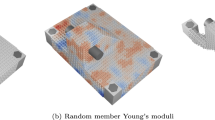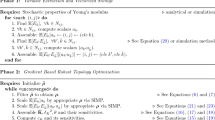Abstract
This paper presents a numerical method to simulate a Gaussian random field over a 3D surface whereas the existing methods in the literature are limited to simple 2D surfaces. This new approach is summarized in the following. First, a covariance function is proposed based on the shortest path between two points on the 3D surface. Second, the Karhunen–Loève expansion is discretized using a coupling between two methods: the Galerkin method with the fast marching method (for computing the covariance function with the shortest path). The proposed numerical method is illustrated with an application to a composite structure representing a chair. The fiber volume fraction, the ratio between fibers and resin volumes, is considered to be uncertain. This uncertain parameter is directly linked to the mechanical parameters of the material. The structural integrity of this structure is represented by the maximal deflection and the maximal Tsai–Wu criterion. Monte Carlo simulations are used to carry out the uncertainty quantification of these responses with respect to the uncertain parameter.






Similar content being viewed by others
References
Mesogitis TS, Skordos AA, Long AC (2014) Uncertainty in the manufacturing of fibrous thermosetting composites: a review. Compos Part A Appl Sci Manuf 57:67–75
Sriramula S, Chryssanthopoulos MK (2009) Quantification of uncertainty modelling in stochastic analysis of FRP composites. Compos Part A 40:1673–1684
Fertig RS, Jensen EM, Malusare KA (January 2014) Effect of fiber volume fraction variation across multiple length scales on composite stress variation: the possibility of stochastic multiscale analysis. In: 55th AIAA/ASMe/ASCE/AHS/SC structures, structural dynamics, and materials conference
Zhang F, Comas-Cardona S, Binetruy C (2012) Statistical modeling of in-plane permeability of non-woven random fibrous reinforcement. Compos Sci Technol 72:1368–1379
Mesogitis TS, Skordos AA, Long AC (2015) Stochastic simulation of the influence of cure kinetics uncertainty on composites cure. Compos Sci Technol 110:145–151
Desplentere F (2007) Multiscale modelling of stochastic effects in mould filling simulations for thermoplastic composites. PhD Thesis, Katholieke Universiteit Leuven
Endruweit A, Wong CC, Harrison P, Long AC (2005) Dual-scale modelling of flow through non-uniform bi-directional fabrics. ICCM-15 Durban, S. Africa June 27–July 2
Endruweit A, Long AC (2006) Influence of stochastic variations in the fibre spacing on the permeability of bi-directional textile fabrics. Compos Part A 37:679–694
Endruweit A, Gommer F, Long AC (2013) Stochastic analysis of fibre volume fraction and permeability in fibre bundles with random filament arrangement. Compos Part A 49:109–118
Skordos AA, Sutcliffe MPF (2008) Stochastic simulation of woven composites forming. Compos Sci Technol 68(1):283–296
Huang S, Mahadevan S, Rebba R (2007) Collocation-based stochastic finite element analysis for random field problems. Probab Eng Mech 22(2):194–205
Verleye B, Nuyens D, Walbran A, Gan M (July 2012) Uncertainty quantification in liquid composite moulding processes. In: Proceedings of the FPCM11 conference, Auckland 9–12
Gommer F (2013) Stochastic modelling of textile structures for resin flow analysis. PhD thesis, University of Nottingham
Park M, Tretyakov MV (2015) A block circulant embedding method for simulation of stationary Gaussian random fields on block-regular grids. Int J Uncertain Quantif 5(6):24–35
Dietrich CR, Newsam GN (1997) Fast and exact simulation of stationary Gaussian processes through circulant embedding of the covariance matrix. SIAM J Sci Comput 18(4):S167–S196
Davies TM, Bryant DJ (2013) On circulant embedding for Gaussian random fields in R. J Stat Softw 55(9):1–21
Ghanem R, Spanos P (1991) Stochastic finite elements: a spectral approach. Springer, Berlin
Chen NZ, Guedes Soares C (2008) Spectral stochastic finite element analysis for laminated composite plates. Comput Methods Appl Mech Eng 197(51):4830–4839
Ngah MF, Young A (2007) Application of the spectral stochastic finite element method for performance prediction of composite structures. Compos Struct 78(3):447–456
Bostanabad R, Chen W, Apley DW (2016) Characterization and reconstruction of 3D stochastic microstructures via supervised learning. J Microsc 264(3):282–297
Bostanabad R, Bui AT, Xie W, Apley DW, Chena W (2016) Stochastic microstructure characterization and reconstruction via supervised learning. Acta Mater 103:89–102
Apley DW, Liu J, Chen W (2006) Understanding the effects of model uncertainty in robust design with computer experiments. J Mech Des 128(4):945–958
McFarland J, Mahadevan S, Romero V, Swiler L (2008) Calibration and uncertainty analysis for computer simulations with multivariate output. AIAA J 46(5):1253–1265
Liu WK, Belytschko T, Mani A (1986) Random field finite elements. Int J Numer Methods Eng 23(10):1831–1845
Liu WK, Belytschko T, Mani A (1986) Probabilistic finite elements for nonlinear structural dynamics. Comput Methods Appl Mech Eng 56(1):61–81
Bostanabad R, Kearney T, Tao S, Apley DW, Chena W (2018) Leveraging the nugget parameter for efficient gaussian process modeling. Int J Numer Methods Eng 14(5):501–516
Ilyani Akmar AB, Lahmer T, Bordas SPA, Beex LAA, Rabczuk T (2014) Uncertainty quantification of dry woven fabrics: a sensitivity analysis on material properties. Compos Struct 116:1–17
Savvas D, Stefanou G (2017) Assessment of the effect of microstructural uncertainty on the macroscopic properties of random composite materials. J Compos Mater 51(19):3012–3024
Rasmussen CE, Williams CKI (2006) Gaussian processes for machine learning. The MIT Press, Cambridge
SubsTech. http://www.substech.com
Zhu J, Zhu H, Njuguna J, Abhyankar H (2013) Recent development of flax fibres and their reinforced composites based on different polymeric matrices. Materials 6(11):5171–5198
Yan L, Chouw N, Yuan X (2012) Improving the mechanical properties of natural fibre fabric reinforced epoxy composites by alkali treatment. J Reinf Plast Compos 31(6):425–437
Guilleminot J, Soize C, Binetruy C (2008) Theoretical framework and experimental procedure for modelling mesoscopic volume fraction stochastic fluctuations in fiber reinforced composites. Int J Solids Struct 45(21):5567–5583
Robert C (1996) Méthodes de Monte Carlo par Chaînes de Markov. Economica 1:2
Betz W, Papaioannou I, Straub D (2011) Numerical methods for the discretization of random fields by means of the Karhunen–Loève expansion. Comput Methods Appl Mech Eng 271(1):109–129
Sethian JA (1999) Level set methods and fast marching methods: evolving interfaces in computational geometry, fluid mechanics, computer vision, and materials science. Cambridge University Press, Cambridge
Author information
Authors and Affiliations
Corresponding author
Additional information
Publisher's Note
Springer Nature remains neutral with regard to jurisdictional claims in published maps and institutional affiliations.
Rights and permissions
About this article
Cite this article
Zein, S., Laurent, A. & Dumas, D. Simulation of a Gaussian random field over a 3D surface for the uncertainty quantification in the composite structures. Comput Mech 63, 1083–1090 (2019). https://doi.org/10.1007/s00466-018-1637-y
Received:
Accepted:
Published:
Issue Date:
DOI: https://doi.org/10.1007/s00466-018-1637-y




